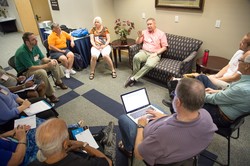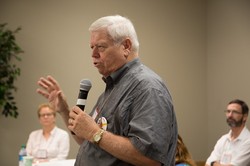Meeting July 29 and 30 on the campus of the University of Tennessee in Knoxville, representatives of the Presbyterian Church (U.S.A.)’s mid-councils—synod and presbytery executives and stated clerks—worshiped, talked, and celebrated and pondered the ongoing mission of the PC(USA).
Discussion groups over the two days addressed topics such as the 222nd General Assembly (2016), worship resources, communications, mission partnerships, ecumenical and interfaith work, race relations, the future of funding and immigration ministries.
A panel discussion—with Presbyterian Mission Agency and Office of General Assembly staff, board members and mid-council representatives—fielded questions about church growth, synod boundaries, allocation of resources and the role of mid councils.
“We need to ask the right questions, not just about mid-councils, but [about] the role of the church,” said the Rev. Gradye Parsons, stated clerk of the Office of the General Assembly. “We don’t seem to know who we are. Until we know who we are at the core, how can [others] value us?”
He went on to say that a “new chapter” of the PC(USA) started June 21, 2014, when the 221st General Assembly passed the marriage equality overtures.
“It’s a critical time, a kairos time and a chronos time, for us to have a conversation about who we are,” he said. “Structure and resources follow mission and purpose. We have to ask, ‘What is the church that God has called us to be in the 21st century?’” Parsons also noted this is a question all denominations are asking at this time.
Addressing questions regarding the structure of the Presbyterian Mission Agency Board (PMAB) and if she feels there is something fundamentally wrong with how Presbyterian Mission Agency and its board function together, board chair the Rev. Marilyn Gamm responded, “That particular question is a question we are asking ourselves.”
“There has been a complete breakdown of trust on how the board and staff interact,” she continued, adding a hopeful note. “We are seeking to rebuild that relationship. We recognize that trust is broken. This is an opportunity to begin conversations that might work toward [rebuilding relationships.]”

Chip Hardwick, director of Theology, Formation and eEducation, speaks about new worship resources with a breakout group at the mid-council meeting held prior to Big Tent 2015. —Gregg Brekke
In a prepared statement that, in part, addressed the two ongoing lawsuits against the PC(USA) and the investigation into the founding of the Presbyterian Centers for New Church Innovations, Inc., (PCNCI), Gamm said, “I take full responsibility for having taken the idea of doing an investigation to the Executive Committee. I stand by that decision. At this time the investigation report is protected by attorney/client privilege and I therefore will not comment upon nor discuss any aspect of that report, nor any aspect of our legal strategy as we defend ourselves in these suits. I’d say you have to trust me, but I know many don’t, and that’s a tension we have to live with.”
“No per-capita dollars were spent on the investigation nor are being spent on the lawsuit or legal defense,” she said when pressed for comment, conceding that more than one million dollars of unrestricted mission funds had been used in the PCNCI investigation. “We’re looking at priorities. It’s a joint staff and board endeavor with an outside consultant. We had some beginning conversations at the Executive Committee retreat about the [PMA] board structure and [whether] it’s the best structure for us at this time. Should some, or all, of the six national agencies merge, and what would be the best possible outcome of that?”
Questions regarding the agency, its financial state and the status and progress of the search for an interim and elected executive director carried over to the next day in a discussion group titled, PMA Moving Forward.
The Rev. Susan Faye Wonderland from the Synod of the Trinity asked if the board was moving too quickly in its decision to hire an interim director and in its proposal to present a candidate for election by the 222nd General Assembly (2016).
Gamm said the transition team was looking for two people with very different job requirements. “One has the hard job of making tough financial decisions to set the PMA on secure financial footing, [while] the other, elected position will take the church forward.”
Gamm shed light on those tough financial decisions in her previous day’s comments, saying the agency has generally experienced a reduction in force “every spring, especially in General Assembly years.”
“With each RIF [reduction in force] we insist staff output remain constant,” she noted of the work priorities for agency employees. “We see this as the perfect storm [the financial crisis and the search for a new executive director] preparing us to become a leaner, more efficient church.”
She said the board would be asking questions to address these efficiencies, such as: “Who do we serve and why? What is our mission? What is our calling? Why do we have and why do we need a national church structure and national church offices?”
Addressing the pending “fiscal cliff” the agency will reach in late 2015 or 2016, she said, “We’ve been heading toward this financial crisis for at least 20, if not 30, years. We need a person to be able to evaluate and reorganize quickly, and we don’t expect that to be done by General Assembly [in 2016.] The search for the full time ED could take up to three years.”
“We’ve struggled with what’s the right amount of time to spend in the search process,” said Jo Stewart, vice chair of the board. “Finding and hiring that person [the elected ED] would bring some stability and security to the PMA.”
While acknowledging that a budget needs to be presented to the General Assembly that will help avoid or forestall the “fiscal cliff,” Barry Creech, interim co-manager of the Mission Agency, said a two-year Bridge Mission Work Plan will be presented in February 2016 and will reflect goals through 2018, adding, “All the trains are on the same track, leading to [the 222nd General Assembly in] Portland.”

